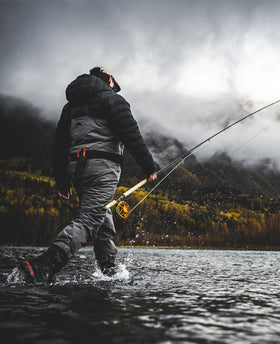
3 Flies for the Week: April 29
As the spring continues on, the freestones are getting bigger and bigger! Right now may be the threshold where fishing the tailwaters would be a better option if you’re looking to get out. Although the freestone flows still aren’t too crazy, they’re getting big and dirty and may not produce the best fishing. That said, if you’re really wanting to go to a freestone we recommend the upper stretches of these rivers or the smaller creeks, such as Bear and Clear. We wouldn’t necessarily recommend fishing Pueblo right now due to the high releases coming from Pueblo Reservoir.
Aside from that, Cheesman, Deckers, 11 Mile, Dream Stream, the Blue in both stretches, and the Williams Fork are at great flows and have been fishing consistently. The past two weeks I’ve been recommending flies that are generally leaning towards fishing freestones. This week I’ll be highlighting three flies that would better suit the tailwater world. Like always, nymphing will be your best friend on the tailwaters, but when the right conditions call don’t be afraid to fish some dries!
#1: UV Scud - Orange sz14 (In-Store Only)
Aside from worms, one of the best lead flies for nymph rigs in the spring time are scuds. Scuds are present in most Colorado tailwaters and are a trout favorite. Like all crustaceans, they are packed with nutrients and calories and the trout know this. They aren’t readily available to the fish all year though, the majority of the time they are locked in their homes in predominantly weedy areas. As I’m sure most of you know, weeds grow and become thicker throughout the year. Therefore, the homes of the scuds become stronger and stronger and allow them to avoid predation. But in earlier times of the year when weeds are at the lowest they’ll be, they’re prone to getting knocked around the river.
This time of the year is when that occurs. Fluctuating water flows that are generally higher will kick them loose and usually during this process they will die before a trout even touches them. I don’t know why this occurs (so don’t ask haha), but it does. Live scuds are typically tan, olive, or gray in coloration, but dead scuds typically present orange or pink. With so many scuds getting knocked around this time of the year, we recommend fishing dead scuds. Oftentimes we’ll have days where they’ll deny a live imitation, but as soon as we switch over to a dead one we can’t keep the fish away. This is merely a figure of speech, but you get what I’m saying. The UV in this particular fly helps a lot when the water is higher, dirty, and/or a faster section of water. Oftentimes in these conditions the fish won’t be able to see your specific fly in the midst of a ton of other food options, so the UV attracts more sunlight and makes it pop out to the fish.
#2: Splitback Shady - BWO sz22
Just because it’s almost May doesn’t mean the BWO’s are going away anytime soon, particularly on the tailwaters. Water temperatures are remaining cool enough to keep the bugs hatching consistently. I know I’ve mentioned this in past blogs, but for some reason when mayflies are hatching the trout just cannot stay away from eating them. I’ve seen them disregard other hatches that have bigger bugs and solely eat the mayflies. Again, I don’t know why this occurs but it does. One of our favorite bugs in the shop that we use during the BWO hatches is the slim shady and splitback shady. Both of these patterns perfectly resemble a BWO and fool fish on a daily basis. This version of the shady has a splitback on the thorax of the body to resemble a nymph’s case splitting apart and preparing to emerge. This is an important fly to have in your box because there are very few flies that resemble a BWO that aren’t a standard nymph or emerger. Fish this as your second or third fly on a nymph rig.
#3: Foamie Homie - Brown sz24
Midges hatch every single day of the year and now with warmer water temperatures they are hatching more frequently than any other hatch. Midges don’t really produce during the middle of the day, but fishing in the early morning and late afternoon they are the most important fly to have on your rig because they will be hatching in clouds in both timeframes. Midges are small, so if you’re willing or able to fish small bugs, we recommend trying to match the size of the natural bugs. Generally, this would mean fishing a sz26 down to a sz30, but we don’t think this is too important. Sz24 midges are perfect for year-round midge hatches and are arguably the only size that you need in your box. The foamie homie is an awesome emerger pattern for midge hatches for two reasons. First off, the small foam section on the thorax does an excellent job of resembling a natural emerging midge. Secondly, the small flash section helps grab the fish’s eye and separate itself from the thousands of naturals in the water. I’m sure you’ve seen this fly on the list before but we like it so much it’s hard not recommending it!
Best of luck on the water this week and we hope these flies catch a fish or two for ya. Two out of the three flies are available on our website and all are available in the shop. If you have any questions or concerns, feel free to reach out to Xavier on email at xavier@goldenflyshop.com, or call the shop at 303-330-1292. Thank you!




Leave a comment